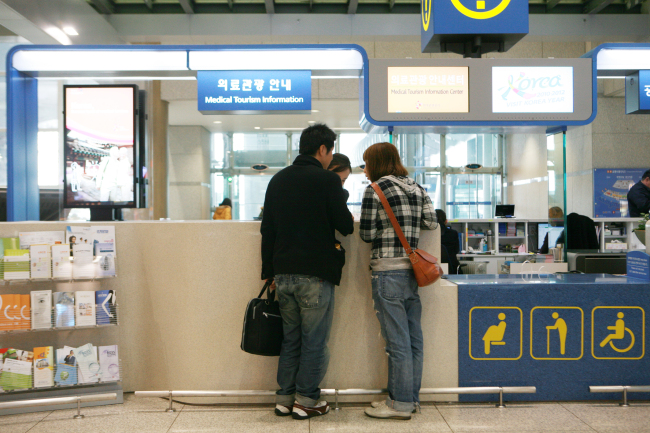[Weekender] Services to help you make the most of your time in Korea
By Paul KerryPublished : Jan. 26, 2018 - 18:44
From superfast delivery to near ubiquitous Wi-Fi, Korea has a wealth of conveniences that would make many rivals blush.
But the language barrier and an idiosyncratic internet environment have often made it difficult for visitors to take advantage.
With a growing foreign population and tourism industry -- a record 17 million people visited the country in 2016 -- Korea has worked hard to make the country more accessible, with tech a particular plus if you know where to look.
Apps and assistance exist to help ensure your taxi driver does not proudly chauffeur you to a sewage farm and you don’t order arrowroot thinking it’s Assam. There are also tourist-targeted offers and services to help you save time and money. Here’s a rundown of what’s available.
But the language barrier and an idiosyncratic internet environment have often made it difficult for visitors to take advantage.
With a growing foreign population and tourism industry -- a record 17 million people visited the country in 2016 -- Korea has worked hard to make the country more accessible, with tech a particular plus if you know where to look.
Apps and assistance exist to help ensure your taxi driver does not proudly chauffeur you to a sewage farm and you don’t order arrowroot thinking it’s Assam. There are also tourist-targeted offers and services to help you save time and money. Here’s a rundown of what’s available.

Finding your feet
Korea runs a national tourist helpline, dial 1330, with information in English, Chinese and Japanese. In Seoul, the Dasan call center, dial 120, offers support in those languages plus Vietnamese and Mongolian, including information about tourism and everyday living, as well as interpretation by phone to help you deal with shops, taxis and other things.
The Korean Tourism Organization offers information on sites to see and other aspects of Korea in 12 languages at www.visitkorea.or.kr, while korea4expats.com and angloinfo.com/seoul provide info and event information in English. hapskorea.com and Daegucompass.com provide city-specific guides.
The PyeongChang Olympic Games Organizing Committee has both a general app with a collated set of useful information for visitors and a Go PyeongChang app designed to help visitors get to and from events. The Go app has a map and navigation function, lets users buy train tickets and links them to ride-hailing services, but both apps are less useful than their alternatives outside of an Olympic context.
Finding your way
Some online services don’t work the same in Korea as overseas, including Google Maps. Many of the basic map functions do still work, but some, such as for directions, are not available. The two big Korean portal operators, Naver and Kakao, both have comprehensive map apps available in English, with Naver also offering French, Japanese and Chinese. Both Korean options have a route finder for walking, driving and public transport, have street view equivalents and even let you check the traffic via CCTV.
Naver has a more complete English listing of places on the map, though both apps still list some in Korean. It also has a navigation app for drivers.
Kakao’s app links to its ride hailing service, Kakao T, and its imaginatively named Road View function lets you toggle the date, so you can tell if that restaurant you found in a battered copy of the Lonely Planet really was there once upon a time, or you are just looking in the wrong place.
Get moving
Another common service overseas, Uber, is not allowed to run its regular service in Korea because private cars can’t legally operate as taxis, although its higher-end services do run.
The most common ride-hailing service in Korea is Kakao T (otherwise referred to as Kakao Taxi). There is an English app, though optional services such as in-app payment are only available in Korean. After you put in your pickup point and destination, the app calls a taxi and transmits navigation information to it while telling the passenger the last four digits of the vehicle’s license plate. Payment is the same as for regularly hailed taxis.
If you are in Seoul and know in advance when you will be traveling, you can order an International Taxi at www.intltaxi.co.kr. The service is slightly more expensive, but uses vetted drivers with better language skills.
In addition to the map apps, Korail’s website, www.letskorail.com has an English section, and www.hticket.co.kr offers intercity bus services (click the top left menu for language options).
T-money prepaid cards can be used to get cheaper fares on local public transport. You can also use them to pay for other things such as airport buses and taxis -- as well as at subway vending machines. Counterintuitively, they are mostly sold at convenience stores, with only some stations offering them at self-service kiosks (they're bigger than the regular top-up machines, which only sell one-use cards).
Getting message across
Though its maps are limited, Google’s translate service is the same as overseas, and the option on the app to use the phone's camera to read text works quite well for Korean menus and signs. The translations are a bit brusque, however, and tend to handle idiomatic language a little too literally. That’s great if you really do have butterflies in your digestive system, but less so for Brits who want their taxi driver to put something in the boot.
Naver’s Papago translation app produces more natural Korean and handles idiomatic language better, but is limited to eight languages. It also has a camera function, though it works a little differently.
For more basic language needs, Naver’s dictionary (dic.naver.com) is the most popular in Korea.
Splashing out
Korea offers tax refunds from participating shops to tourists who show their passports for shopping, with a limit of up to 5 million won ($4,700). Look for the “tax free” signs. Some shops, usually large ones, offer a tax refund immediately as a discount, while others let you claim it back at the airport and some service centers.
In addition, the annual Korea Grand Sale with special offers tailored to tourists runs until Feb. 28. Find out more at www.koreagrandsale.co.kr.
Major supermarkets are closed on the second and fourth Sundays of each month. But if, like many, you find it hard to keep track, there’s always ishomeplusopen.com, an unofficial site that needs no explanation.
Korea is famous for its delivery services, but most food ordering apps are only available in Korean. However, www.shuttledelivery.co.kr offers service in English, although coverage is more limited than its Korean rivals and it is more expensive.
Cinemas can be found via cineinkorea.com, with its searchable schedule of what’s on across the country. Korean films are sometimes shown with English or Japanese subtitles. Kids’ films are often offered with either Korean subtitles or dubbing, so check which it is before going.
If it all goes wrong
If you find yourself in need of help, the emergency lines have interpreters available in several languages. Dial 119 for fire and ambulance and 112 for police.
In certain areas, such as Myeong-dong, Hongdae and Incheon Airport, there are tourist police stationed to help with interpretation, general assistance and tourist specific problems such as price gouging.
The Korea National Police Agency also runs a service for lost property at www.lost112.go.kr.
The main search page is in Korean, but there is a guide on how to use it in the English section of the site.
During the Olympics, Gangwon Province will run nine counseling centers for victims of sexual assault and harassment, with English-speaking staff at each one.
In addition the Danuri call center (1577-1366) operates year-round in 13 languages and has staff trained to provide counseling for victims of sex crimes, as well as human rights and migrant issues.
By Paul Kerry (paulkerry@heraldcorp.com)







![[Graphic News] More Koreans say they plan long-distance trips this year](http://res.heraldm.com/phpwas/restmb_idxmake.php?idx=644&simg=/content/image/2024/04/17/20240417050828_0.gif&u=)
![[KH Explains] Hyundai's full hybrid edge to pay off amid slow transition to pure EVs](http://res.heraldm.com/phpwas/restmb_idxmake.php?idx=644&simg=/content/image/2024/04/18/20240418050645_0.jpg&u=20240419100350)






![[From the Scene] Monks, Buddhists hail return of remains of Buddhas](http://res.heraldm.com/phpwas/restmb_idxmake.php?idx=652&simg=/content/image/2024/04/19/20240419050617_0.jpg&u=20240419175937)

![[KH Explains] Hyundai's full hybrid edge to pay off amid slow transition to pure EVs](http://res.heraldm.com/phpwas/restmb_idxmake.php?idx=652&simg=/content/image/2024/04/18/20240418050645_0.jpg&u=20240419100350)

![[Today’s K-pop] Illit drops debut single remix](http://res.heraldm.com/phpwas/restmb_idxmake.php?idx=642&simg=/content/image/2024/04/19/20240419050612_0.jpg&u=)